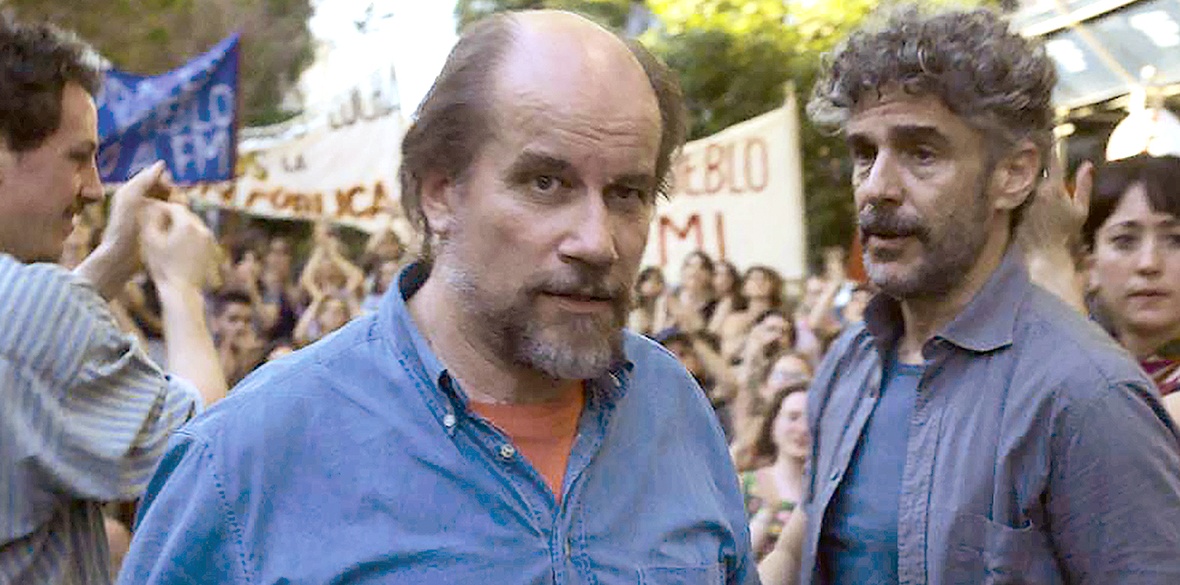Colman Domingo as Bayard Rustin in Rustin | Netflix, 2023
Reposted from Jacobin
Netflix’s new feel-good Bayard Rustin biopic, Rustin, claims the civil rights hero has been forgotten because of his sexuality. But it was his fiery and provocative class politics that makes him both controversial and prophetic today.
Rustin, directed by George C. Wolfe and produced by Barack and Michelle Obama, is largely a retelling of the mythic story of the civil rights movement but now with the addition of a new character — Bayard Rustin, played capably by Colman Domingo. Here once again is Martin Luther King Jr (Aml Ameen) as the savior and singular embodiment of the movement. The March on Washington for Jobs and Freedom is presented as the apotheosis and catalyst for the triumph of the Civil Rights Act and Voting Rights Act. But in order to seamlessly fit Rustin into this familiar narrative, the filmmakers depict him as the long forgotten sidekick of Dr King. In one of Rustin’s final scenes, MLK looks back wistfully at Bayard just after he finishes his iconic “I Have a Dream” speech. Voila! Bayard has been redeemed and the mythic narrative of the civil rights movement is preserved.
Anyone even passingly familiar with Rustin’s life and work should find this version offensive. Not because it fudges some historical details (it’s a movie), but because it’s an insult to Rustin’s actual contribution while shoving his political vision completely out of frame. In this way, Rustin does more to help us forget what Bayard actually stood for — especially his cutting critique of the failures of the Left — than it does to honor the man and his contribution.
Neglected History
That Rustin has been forgotten in the canonical story of civil rights is a kind of starting point for the film’s premise. The director seems to think he’s letting us in on a secret. For, according to his telling, Rustin was tragically forgotten because he was gay. And only because of that. Rustin is thus reduced entirely to a tragically persecuted, but tirelessly dedicated, martyr for the cause. The way we are meant to repent for our historical neglect of this great figure is to properly remember Rustin as a gay man first and foremost. Only then can we place him in his rightful place among the pantheon of civil rights greats.
It’s not that Rustin’s sexuality was irrelevant to his public life; indeed it was a major and integral part of who he was and a major part of why Bayard was so often pushed into the background. But there is something peculiar about how the film makes Rustin’s sexuality so central, with the filmmakers even going as far as to create an entirely fictional relationship for Rustin just to demonstrate this.
Elias Taylor (played by Johnny Ramey), the only purely fictional character in the film, is a gay black Christian but also one who is married with a baby on the way. But Rustin’s real life relationship with the young socialist Tom Kahn — who does appear in the film, played by Gus Halper — was far more interesting. It was this duo, Rustin and Kahn, who would work together on the pivotal essay From Protest to Politics, probably Rustin’s chief strategic statement on civil rights after the March on Washington. Khan’s actual role in the film, though, like so many other important characters, is reduced to the status of faithful henchman and perhaps a onetime lover. Why? Because to develop Kahn’s character a bit more — a white socialist — would complicate the film’s message.
It would signal to the viewer that maybe the real ongoing historical neglect of Rustin was, in fact, political in nature; that Rustin’s views — on race, economics, and political strategy — were no less a reason for his official erasure from canonical civil rights history. In a cruel twist, it seems, Rustin’s sexuality has been weaponized yet again. In Rustin’s lifetime, it was used as an excuse to forget him — in his death it’s employed now to make us forget what he stood for.
And these ideas, as we will see, are arguably more intolerable to liberal audiences today, than they were even during his lifetime.
The Cult of Youth
Rustin’s relationship with A. Philip Randolph (Glynn Turman) is another partnership badly butchered by the film. If you didn’t know better you would assume that Martin Luther King Jr was Rustin’s best friend and confidant. Randolph, the father of the civil rights movement and Bayard’s beloved mentor, is portrayed as a doddering old adviser. You get the sense that this guy mattered personally for Rustin, and historically for the movement — but not that he mattered all that much. It’s a depiction that hardly honors Randolph and the remarkable relationship he and Bayard had. And it is one that conveniently privileges younger characters at the expense of the wizened chief.
In one scene Bayard plans his march in a room full of beautiful and stylish young people. A host of intersectional personalities then present foolish ideas in turn, taken straight from the contemporary nonprofit playbook. Yet in this film these kids are depicted, instead, as inspired strategists. In the scene, Rustin swoons as one of them insinuates that not only should the heads of major civil rights organizations speak but so too should the young activists themselves. It’s a perfect demonstration of the Cult of Youth that has captured the liberal mindset for half a century or so. And a cheap way to flatter the sensibilities of the Millennial and Zoomer NGO employees in the audience today.
But not only is it a total fabrication — the very spirit of it goes against every principle Rustin upheld in both his work and his writing. The truth is that Rustin was highly critical — and explicitly so — of the emerging tendency among young radicals to “substitute self-expression for politics” and often complained about the shortsightedness of youthful exuberance getting in the way of reasoned deliberation. All of which is to say Rustin was anything but a youth fetishist. And as for the youth themselves, there was no love lost with them either. In the later 1960s, in fact, the real Rustin would perpetually rumble with the students of the New Left, who took special care to skewer Bayard in their polemical essays and speeches.
Instead of spending his time with wet-behind-the-ears radicals, the real Rustin spent long evenings planning with veteran generals. Not only Randolph but also labor leader Norman Hill, who gets almost no attention in the film, and socialist A. J. Muste, who is portrayed as an out-of-touch peacenik who tells Rustin to get back in the closet, accusing him of reverse-racism — a dramatically useful caricature of the Old White Man.
The problem with leaving these characters out, or distorting their roles, is not merely that certain Great Men didn’t get their due, but that these particular figures represent a now dead political world that this film desperately wants to keep dead. Unfortunately, in Bayard Rustin, the filmmakers have resurrected a historical figure whose actual politics could not be more at odds with the ones they desperately wish he had held instead.
Invisible Labor
Rustin himself credits Randolph for coming up with the very concept of a March for Jobs and Freedom. The first mention of this name for the march, though, is hardly remarked upon in Rustin. The filmmakers seem so embarrassed by the very mention of “jobs” (and jobs first) that they bury it in a meaningless conversation. Again, these aren’t just mistakes. The hip young activists are meant to replace labor and socialist movement veterans like Randolph, Muste, and Hill as the real protagonists of history, just as the Democratic Party has spent years trying to replace their old union voters with “the youth.”
Though expected for any Hollywood film, the extent to which the labor movement is made invisible here is genuinely remarkable. As a friend of mine complained, it’s as if the only reason the unions are consulted at all is because march organizers need more money for latrines. Fitting. Worse, this is precisely the kind of attitude Rustin railed against all his life. “I must confess I find it difficult to understand the prejudice against the labor movement currently fashionable among so many liberals.” Rustin carped in 1970, “These people, for reasons of their own, seem to believe that white workers are affluent members of the Establishment.”
Ironically, the march itself was meant to mend and solidify the relationship between labor and the civil rights movement — not simply legal protections for racial minorities, but economic redistribution and social renewal for all, ideas barely mentioned in Rustin. The real Rustin warned against the fraying of the progressive coalition and worried that both race-forward militancy and a focus on young “stylish liberals” would destroy any social democratic horizon.
It’s with truly remarkable prescience that Rustin fretted in 1969 that a new liberal coalition was forming “to be comprised of the forces at the top — middle-class professionals and the wealthy of good conscience — and the minorities and the poor at the bottom.” But Rustin’s favored coalition, with organizations of the civil rights movement and labor at the center, was dead before it was born. Born in 1912, he was a man of the Old Left. By 1972 he lamented: “What was, at the time of the 1963 March on Washington, a reflection of broad interracial cooperation is, no longer a movement, but a series of causes, each vying with another for ascendancy.”
Today, we live in the long shadow of that era. Rustin succeeds only in making certain that we forget that there was indeed a road not taken.
Anti-Racist?
In the film, we get the impression that Bayard is the consummate anti-racist, modeled in today’s ideological mold. In a key scene he stares down Washington, DC police officials and lectures the cops about what it means to be a “racist” as if the very threat of the word is supposed to shake them. Of course, today, “racist” is the worst thing a liberal can call someone or be called. Yet not only was the word relatively alien to Rustin, but “race prejudice” (the far more common phrase for the time) was not, according to him, even the main problem he was trying to solve.
The real Rustin warned that “we get such a kick out of calling people racists” that we are incapable of seeing the fundamental conflict in society, let alone doing anything about it. That conflict, again according to Rustin, “is between poor people and affluent people. That’s where the problem is, and where it will always be. And it won’t be easy to solve.”
Throughout the film this view is alternatively erased or perverted beyond recognition. Even the very words used are designed to distract or otherwise reframe the problem in ways that Bayard would have found inconceivable or detestable. For instance, instead of discussing “inequality,” screenwriters opted for the word “inequity,” a little sleight of hand that allows Rustin to fit perfectly with today’s dominant anti-racist ideology but was likely nowhere to be found in any of Rustin’s actual writings or speeches.
These little changes make it easy to forget that Rustin’s actual views were controversial on the Left in his time and perhaps even more so today. “To talk about blackness is silly,” Bayard complained in 1968, “anybody who talks of the black agenda is a reactionary.” I wonder how this would play on Twitter/X today? Yet, this is a typical Rustinism, repeatedly expressed, in different ways, across several magazines, in speeches, in union halls, and university lectures. For him, race tribalism was tied to race hatred. “Prejudice,” he was fond of saying “is of a single bit.”
And he noticed that race came to replace many of the issues that he found much more pressing: “I’ll bet you there is not a class on this campus that hasn’t discussed racism,” Rustin charged in a 1969 speech to Clark College. “Our fixation on racism, as important as the problem is,” he continued, “has obscured the effects of the technological revolution,” and the economic roots of so many social ills. A focus on racism was “a cop-out for whites who are titillated and delighted to be called racists.” It served to satisfy their masochism more than anything it did for working-class blacks: “And thus Stokely can come back to the United States and receive $2,500 a lecture for telling white people how they stink.” Sound familiar?
Yet this Rustin could never be shown on the screen today — in fact, this Rustin couldn’t even be tolerated. Instead, liberals today embrace his gay identity because they reject his ideas. Can you imagine a major black character in a prestigious movie or television show railing against the abuses of anti-racism today? Famously, a magician once convinced a live audience that he made the Statue of Liberty disappear by simply turning the stage beneath their feet. For Rustin, race politics operated like that — race activists were illusionists who made the class problem, and all its attendant political complications, disappear.
Now, thanks to Rustin, Bayard himself has become a prop in the illusion.
Thanks, Obama
Leave it to the Obamas to make this movie. Amid a small revival of interest in Rustin’s ideas, shared across journals on the Left and in the political center, they’ve swooped in to make certain that Rustin’s most important contributions, and especially his warnings to the Left, would be forgotten entirely. It’s a tragedy. Because a showcase of Rustin’s ideas could have served as a useful starting point for probing just what went wrong in the late 1960s that has led the Left down such a disastrous path.
Instead, we were served a beautifully staged feel-good film that ultimately allows those of us on the Left to feel self-satisfied at falsely remembering a lost icon. As such we are no better off. And until we’re willing to confront Bayard’s critique seriously, we will continue to make the same basic mistakes that the real Rustin properly warned us against more than fifty years ago.
We will continue to confuse therapeutic protest for meaningful political interventions. Bayard insisted that the Left ought to push for larger economic investments and the socialization of the economy and complained of “dramatic confrontations” that “in no way further the achievement of radical social goals.” Yet today, when riots of frustration break out, Congress responds with guilt and pity instead of investment. In 1969 Rustin groaned that “payments from the rich to the poor” have begun to “take the form of ‘Giving a Damn’ or some other kind of moral philanthropy.”
We will continue to demand radical-sounding solutions that serve conservative ends. Rustin would have argued that the activist demand to defund police budgets can sound too similar, especially in resource-starved neighborhoods, to the conservative call to defund public schools — and the notion that government cannot do anything to solve our problems, that government is the problem. As Bayard warned in 1969, “deracinated liberals may romanticize this politics, nihilistic New Leftists may imitate it” — but ordinary black workers “will be the victims of its powerlessness.”
And when we learn that working-class whites have suffered startling declines in life expectancy, or that overdoses rates have again broken new records, or that Democrats are failing to convince larger and larger shares of non-white working-class voters, we will ignore these problems too. Because we will continue to “get such a kick out of calling people racists.”
In his time, the political pathologies Rustin identified, and the coalition that advocated them, were in their infancy. Maybe we are witnessing their final years today. Or perhaps we are once again trapped in what Rustin would call “a cycle of frustration,” where the hopes of the Obama era have crashed hard on the rocks of Trumpism. Either way, we are at least this lucky — the entire political experience of the late 1960s through today has proven many of Rustin’s most trenchant critiques not only valid but urgent.
It’s best that we don’t forget that.
Dustin Guastella is director of operations for Teamsters Local 623 in Philadelphia.











